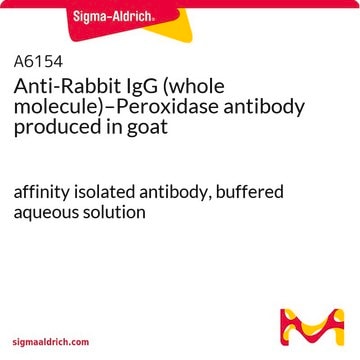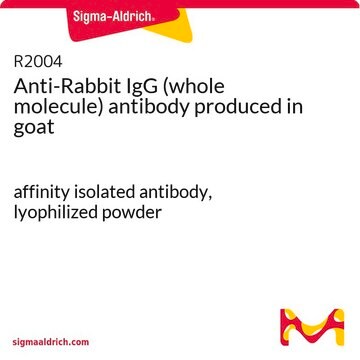B1520
Anti-Bovine Albumin antibody produced in rabbit
whole antiserum
Synonym(s):
Anti-Albumin, bovine serum (BSA)
About This Item
Recommended Products
biological source
rabbit
conjugate
unconjugated
antibody form
whole antiserum
antibody product type
primary antibodies
clone
polyclonal
contains
15 mM sodium azide
species reactivity
bovine
technique(s)
indirect ELISA: 1:200,000
quantitative precipitin assay: 3.0 mg/mL
shipped in
dry ice
storage temp.
−20°C
target post-translational modification
unmodified
Gene Information
bovine ... Alb(280717)
Looking for similar products? Visit Product Comparison Guide
General description
Anti-Bovine Serum Albumin (BSA) was developed in rabbit using purified BSA from Cohn Fraction V as the immunogen. The antiserum has been treated to remove lipoproteins. Strong reactivity with BSA has been determined by immunoelectrophoresis (IEP).
Application
It has also been used for the detection of albumin in nanoparticle using scanning transmission electron microscope.
Biochem/physiol Actions
Human serum albumin as a transporter, is considered as drug delivery vehicle for treating human diseases. Post-translational modifications like glycation and cysteinylation affects the binding functionality of serum albumin. High albumin protein diet has influence on hyperalbuminemia. Low levels of albumin leads to hypoalbuminemia, associated with decreased production and distribution. Hypoalbuminemia is a risk factor for the development of cardiovascular disease.
Physical form
Storage and Stability
Disclaimer
Not finding the right product?
Try our Product Selector Tool.
Storage Class Code
12 - Non Combustible Liquids
WGK
WGK 3
Flash Point(F)
Not applicable
Flash Point(C)
Not applicable
Certificates of Analysis (COA)
Search for Certificates of Analysis (COA) by entering the products Lot/Batch Number. Lot and Batch Numbers can be found on a product’s label following the words ‘Lot’ or ‘Batch’.
Already Own This Product?
Find documentation for the products that you have recently purchased in the Document Library.
Customers Also Viewed
Our team of scientists has experience in all areas of research including Life Science, Material Science, Chemical Synthesis, Chromatography, Analytical and many others.
Contact Technical Service















![1-[3-(Dimethylamino)propyl]-3-ethylcarbodiimide methiodide](/deepweb/assets/sigmaaldrich/product/structures/414/134/4eb9c126-d7f9-4e12-9e3a-95cb077824fd/640/4eb9c126-d7f9-4e12-9e3a-95cb077824fd.png)
